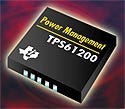May 4, 2007
Originally Published MPMN May 2007
HOTLINE
Low-Input-Voltage Convertor Enables 'Green' Portable Devices
|
A low-input-voltage dc/dc boost convertor can draw power from alternative energy sources for powering mobile medical devices. |
Stimulated by a growing environmental awareness, the push for alternative energy sources and green products is becoming more of a shove. Although environmental concerns have not affected the medical industry as intensely as some others, they will likely factor into future product development when possible. Exercising foresight, Texas Instruments Inc. (TI; Dallas; www.ti.com) has introduced a chip that will enable portable medical devices to draw power from alternative energy sources.
Capable of harvesting energy from such sources as solar and micro fuel cells, the TPS61200 convertor can charge a lithium battery from a single solar cell, according to the company. Owing to this characteristic, the convertor is suited for integration into mobile medical devices used outside of the hospital environment by paramedics or army medics in combat, for example. Alternatively, the product can be employed in a number of general-purpose medical applications powered by 1-, 2- and 3-cell alkaline, nickel-cadmium, and nickel–metal hydride batteries, as well as one-cell lithium batteries.
“We’re not targeting the big solar panels on houses…but we do see that there are a lot of niche applications that use either external solar charging methods or are even integrated into the product themselves,” says Doug Phillips, product marketing manager for TI’s portable power business unit inside of the High-Performance Analog network.
Touted by the company as the industry’s lowest-input-voltage dc/dc boost convertor, the chip can function with input voltages ranging from 0.3 to 5.5 V and has a 0.5-V start-up capability in any load condition. Enabling the convertor to operate with such low input voltages proved to be the key to supporting applications powered by alternative energy sources. Competing convertors typically only can handle input voltages beginning at 0.7 V with a start-up voltage of 0.9 V, which has been the design barrier preventing alternative energy use in the past, according to TI.
Engineered in a 10-pin 3 × 3-mm QFN package, the convertor also features a 1.5-A switch, output short-circuit protection, programmable undervoltage lockout, and a down-conversion mode designed to protect the device when an input voltage rises higher than the output voltage.
“It also has very tight regulation of output voltage over the input voltage range and current range,” Phillips adds. “Because these voltage levels are so low, to be able to manage that even at those levels is pretty unique. It’s one thing to be able to boost up into a higher voltage, it’s another to control it.”
Copyright ©2007 Medical Product Manufacturing News
You May Also Like



